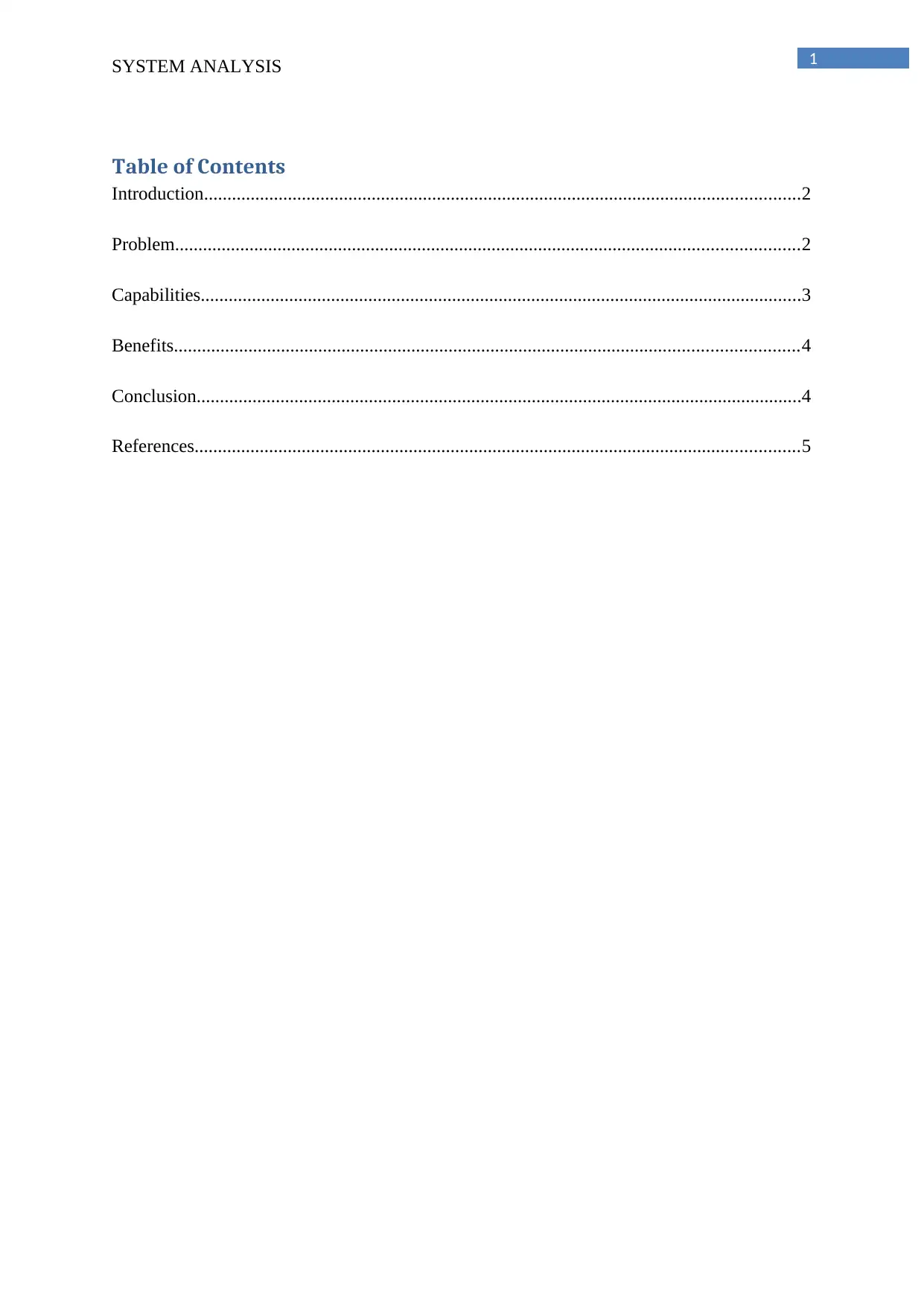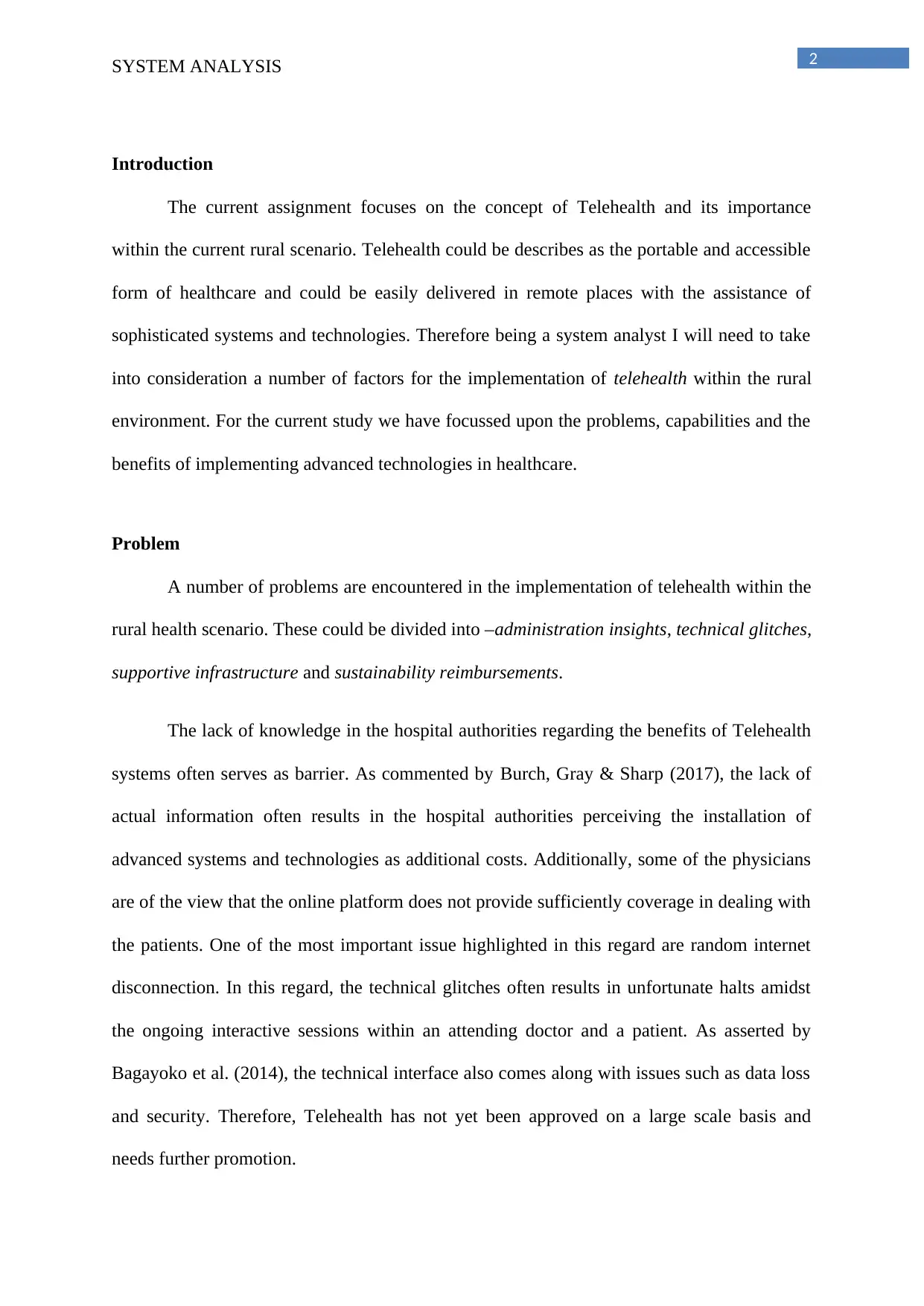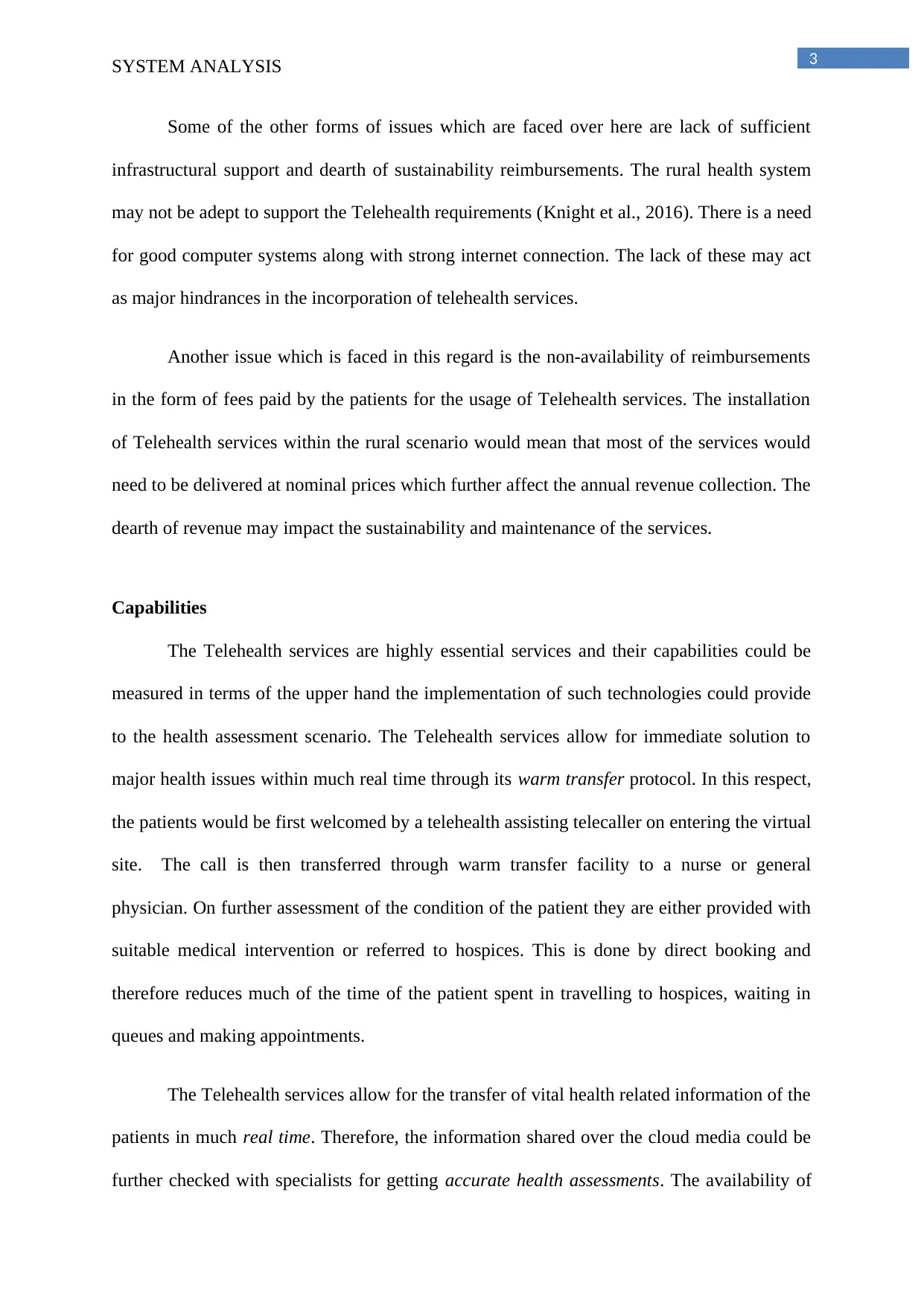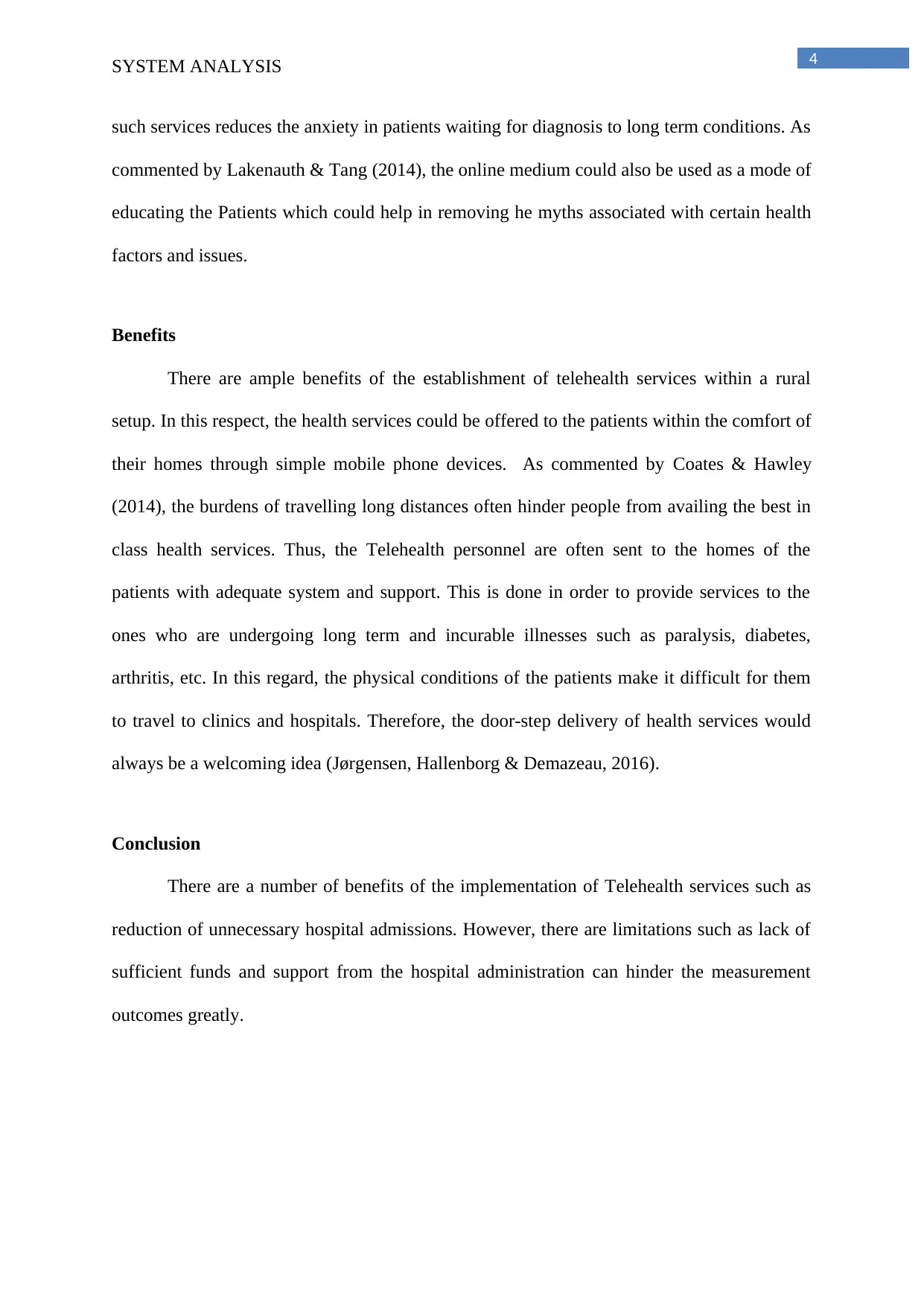Telehealth Implementation in Rural Healthcare: Challenges and Benefits
VerifiedAdded on 2020/04/15
|7
|1281
|241
AI Summary
The assignment focuses on Telehealth's role in rural healthcare, analyzing challenges including administrative barriers, technical glitches, infrastructural inadequacies, and lack of reimbursements. It explores the capabilities of providing immediate health solutions and transferring vital information swiftly while highlighting benefits like reducing unnecessary hospital visits and delivering services at home for chronic patients. Despite its potential, limitations such as insufficient funds and administrative support can hinder success.

Running head: SYSTEM ANALYSIS
System Analysis
Name of the student
University name
Author’s note
System Analysis
Name of the student
University name
Author’s note
Paraphrase This Document
Need a fresh take? Get an instant paraphrase of this document with our AI Paraphraser

1SYSTEM ANALYSIS
Table of Contents
Introduction................................................................................................................................2
Problem......................................................................................................................................2
Capabilities.................................................................................................................................3
Benefits......................................................................................................................................4
Conclusion..................................................................................................................................4
References..................................................................................................................................5
Table of Contents
Introduction................................................................................................................................2
Problem......................................................................................................................................2
Capabilities.................................................................................................................................3
Benefits......................................................................................................................................4
Conclusion..................................................................................................................................4
References..................................................................................................................................5

2SYSTEM ANALYSIS
Introduction
The current assignment focuses on the concept of Telehealth and its importance
within the current rural scenario. Telehealth could be describes as the portable and accessible
form of healthcare and could be easily delivered in remote places with the assistance of
sophisticated systems and technologies. Therefore being a system analyst I will need to take
into consideration a number of factors for the implementation of telehealth within the rural
environment. For the current study we have focussed upon the problems, capabilities and the
benefits of implementing advanced technologies in healthcare.
Problem
A number of problems are encountered in the implementation of telehealth within the
rural health scenario. These could be divided into –administration insights, technical glitches,
supportive infrastructure and sustainability reimbursements.
The lack of knowledge in the hospital authorities regarding the benefits of Telehealth
systems often serves as barrier. As commented by Burch, Gray & Sharp (2017), the lack of
actual information often results in the hospital authorities perceiving the installation of
advanced systems and technologies as additional costs. Additionally, some of the physicians
are of the view that the online platform does not provide sufficiently coverage in dealing with
the patients. One of the most important issue highlighted in this regard are random internet
disconnection. In this regard, the technical glitches often results in unfortunate halts amidst
the ongoing interactive sessions within an attending doctor and a patient. As asserted by
Bagayoko et al. (2014), the technical interface also comes along with issues such as data loss
and security. Therefore, Telehealth has not yet been approved on a large scale basis and
needs further promotion.
Introduction
The current assignment focuses on the concept of Telehealth and its importance
within the current rural scenario. Telehealth could be describes as the portable and accessible
form of healthcare and could be easily delivered in remote places with the assistance of
sophisticated systems and technologies. Therefore being a system analyst I will need to take
into consideration a number of factors for the implementation of telehealth within the rural
environment. For the current study we have focussed upon the problems, capabilities and the
benefits of implementing advanced technologies in healthcare.
Problem
A number of problems are encountered in the implementation of telehealth within the
rural health scenario. These could be divided into –administration insights, technical glitches,
supportive infrastructure and sustainability reimbursements.
The lack of knowledge in the hospital authorities regarding the benefits of Telehealth
systems often serves as barrier. As commented by Burch, Gray & Sharp (2017), the lack of
actual information often results in the hospital authorities perceiving the installation of
advanced systems and technologies as additional costs. Additionally, some of the physicians
are of the view that the online platform does not provide sufficiently coverage in dealing with
the patients. One of the most important issue highlighted in this regard are random internet
disconnection. In this regard, the technical glitches often results in unfortunate halts amidst
the ongoing interactive sessions within an attending doctor and a patient. As asserted by
Bagayoko et al. (2014), the technical interface also comes along with issues such as data loss
and security. Therefore, Telehealth has not yet been approved on a large scale basis and
needs further promotion.
⊘ This is a preview!⊘
Do you want full access?
Subscribe today to unlock all pages.

Trusted by 1+ million students worldwide

3SYSTEM ANALYSIS
Some of the other forms of issues which are faced over here are lack of sufficient
infrastructural support and dearth of sustainability reimbursements. The rural health system
may not be adept to support the Telehealth requirements (Knight et al., 2016). There is a need
for good computer systems along with strong internet connection. The lack of these may act
as major hindrances in the incorporation of telehealth services.
Another issue which is faced in this regard is the non-availability of reimbursements
in the form of fees paid by the patients for the usage of Telehealth services. The installation
of Telehealth services within the rural scenario would mean that most of the services would
need to be delivered at nominal prices which further affect the annual revenue collection. The
dearth of revenue may impact the sustainability and maintenance of the services.
Capabilities
The Telehealth services are highly essential services and their capabilities could be
measured in terms of the upper hand the implementation of such technologies could provide
to the health assessment scenario. The Telehealth services allow for immediate solution to
major health issues within much real time through its warm transfer protocol. In this respect,
the patients would be first welcomed by a telehealth assisting telecaller on entering the virtual
site. The call is then transferred through warm transfer facility to a nurse or general
physician. On further assessment of the condition of the patient they are either provided with
suitable medical intervention or referred to hospices. This is done by direct booking and
therefore reduces much of the time of the patient spent in travelling to hospices, waiting in
queues and making appointments.
The Telehealth services allow for the transfer of vital health related information of the
patients in much real time. Therefore, the information shared over the cloud media could be
further checked with specialists for getting accurate health assessments. The availability of
Some of the other forms of issues which are faced over here are lack of sufficient
infrastructural support and dearth of sustainability reimbursements. The rural health system
may not be adept to support the Telehealth requirements (Knight et al., 2016). There is a need
for good computer systems along with strong internet connection. The lack of these may act
as major hindrances in the incorporation of telehealth services.
Another issue which is faced in this regard is the non-availability of reimbursements
in the form of fees paid by the patients for the usage of Telehealth services. The installation
of Telehealth services within the rural scenario would mean that most of the services would
need to be delivered at nominal prices which further affect the annual revenue collection. The
dearth of revenue may impact the sustainability and maintenance of the services.
Capabilities
The Telehealth services are highly essential services and their capabilities could be
measured in terms of the upper hand the implementation of such technologies could provide
to the health assessment scenario. The Telehealth services allow for immediate solution to
major health issues within much real time through its warm transfer protocol. In this respect,
the patients would be first welcomed by a telehealth assisting telecaller on entering the virtual
site. The call is then transferred through warm transfer facility to a nurse or general
physician. On further assessment of the condition of the patient they are either provided with
suitable medical intervention or referred to hospices. This is done by direct booking and
therefore reduces much of the time of the patient spent in travelling to hospices, waiting in
queues and making appointments.
The Telehealth services allow for the transfer of vital health related information of the
patients in much real time. Therefore, the information shared over the cloud media could be
further checked with specialists for getting accurate health assessments. The availability of
Paraphrase This Document
Need a fresh take? Get an instant paraphrase of this document with our AI Paraphraser

4SYSTEM ANALYSIS
such services reduces the anxiety in patients waiting for diagnosis to long term conditions. As
commented by Lakenauth & Tang (2014), the online medium could also be used as a mode of
educating the Patients which could help in removing he myths associated with certain health
factors and issues.
Benefits
There are ample benefits of the establishment of telehealth services within a rural
setup. In this respect, the health services could be offered to the patients within the comfort of
their homes through simple mobile phone devices. As commented by Coates & Hawley
(2014), the burdens of travelling long distances often hinder people from availing the best in
class health services. Thus, the Telehealth personnel are often sent to the homes of the
patients with adequate system and support. This is done in order to provide services to the
ones who are undergoing long term and incurable illnesses such as paralysis, diabetes,
arthritis, etc. In this regard, the physical conditions of the patients make it difficult for them
to travel to clinics and hospitals. Therefore, the door-step delivery of health services would
always be a welcoming idea (Jørgensen, Hallenborg & Demazeau, 2016).
Conclusion
There are a number of benefits of the implementation of Telehealth services such as
reduction of unnecessary hospital admissions. However, there are limitations such as lack of
sufficient funds and support from the hospital administration can hinder the measurement
outcomes greatly.
such services reduces the anxiety in patients waiting for diagnosis to long term conditions. As
commented by Lakenauth & Tang (2014), the online medium could also be used as a mode of
educating the Patients which could help in removing he myths associated with certain health
factors and issues.
Benefits
There are ample benefits of the establishment of telehealth services within a rural
setup. In this respect, the health services could be offered to the patients within the comfort of
their homes through simple mobile phone devices. As commented by Coates & Hawley
(2014), the burdens of travelling long distances often hinder people from availing the best in
class health services. Thus, the Telehealth personnel are often sent to the homes of the
patients with adequate system and support. This is done in order to provide services to the
ones who are undergoing long term and incurable illnesses such as paralysis, diabetes,
arthritis, etc. In this regard, the physical conditions of the patients make it difficult for them
to travel to clinics and hospitals. Therefore, the door-step delivery of health services would
always be a welcoming idea (Jørgensen, Hallenborg & Demazeau, 2016).
Conclusion
There are a number of benefits of the implementation of Telehealth services such as
reduction of unnecessary hospital admissions. However, there are limitations such as lack of
sufficient funds and support from the hospital administration can hinder the measurement
outcomes greatly.

5SYSTEM ANALYSIS
References
Bagayoko, C. O., Traoré, D., Thevoz, L., Diabaté, S., Pecoul, D., Niang, M., ... &
Geissbuhler, A. (2014). Medical and economic benefits of telehealth in low-and
middle-income countries: results of a study in four district hospitals in Mali. BMC
health services research, 14(1), S9.
Burch, S., Gray, D., & Sharp, J. (2017). The power and potential of telehealth what health
systems should know: proposed legislation in Congress offers the promise that the
nation's healthcare policy will support the expansion of telehealth, allowing hospitals
and health systems to fully realize the benefits of this important emerging approach to
care. Healthcare Financial Management, 71(2), 46-50.
Coates, L., & Hawley, M. (2014). Understanding the operational, organisational and financial
challenges in telehealth adoption through multi-disciplinary collaborative
research. International Journal of Integrated Care, 14(8), pp15-25.
Jørgensen, D. B., Hallenborg, K., & Demazeau, Y. (2016, October). Extending Agent Based
Telehealth Platform with Activities of Daily Living Reasoning Capabilities.
In Healthcare Informatics (ICHI), 2016 IEEE International Conference on(pp. 168-
176). IEEE.
Knight, P., Bonney, A., Teuss, G., Guppy, M., Lafferre, D., Mullan, J., & Barnett, S. (2016).
Positive clinical outcomes are synergistic with positive educational outcomes when
using telehealth consulting in general practice: a mixed-methods study. Journal of
medical Internet research, 18(2), pp.55-62.
References
Bagayoko, C. O., Traoré, D., Thevoz, L., Diabaté, S., Pecoul, D., Niang, M., ... &
Geissbuhler, A. (2014). Medical and economic benefits of telehealth in low-and
middle-income countries: results of a study in four district hospitals in Mali. BMC
health services research, 14(1), S9.
Burch, S., Gray, D., & Sharp, J. (2017). The power and potential of telehealth what health
systems should know: proposed legislation in Congress offers the promise that the
nation's healthcare policy will support the expansion of telehealth, allowing hospitals
and health systems to fully realize the benefits of this important emerging approach to
care. Healthcare Financial Management, 71(2), 46-50.
Coates, L., & Hawley, M. (2014). Understanding the operational, organisational and financial
challenges in telehealth adoption through multi-disciplinary collaborative
research. International Journal of Integrated Care, 14(8), pp15-25.
Jørgensen, D. B., Hallenborg, K., & Demazeau, Y. (2016, October). Extending Agent Based
Telehealth Platform with Activities of Daily Living Reasoning Capabilities.
In Healthcare Informatics (ICHI), 2016 IEEE International Conference on(pp. 168-
176). IEEE.
Knight, P., Bonney, A., Teuss, G., Guppy, M., Lafferre, D., Mullan, J., & Barnett, S. (2016).
Positive clinical outcomes are synergistic with positive educational outcomes when
using telehealth consulting in general practice: a mixed-methods study. Journal of
medical Internet research, 18(2), pp.55-62.
⊘ This is a preview!⊘
Do you want full access?
Subscribe today to unlock all pages.

Trusted by 1+ million students worldwide

6SYSTEM ANALYSIS
Lakenauth, G., & Tang, S. (2014, May). Benefits of Telehealth across different socio-
economic communities. In Systems, Applications and Technology Conference
(LISAT), 2014 IEEE Long Island (pp. 1-6). IEEE.
Lakenauth, G., & Tang, S. (2014, May). Benefits of Telehealth across different socio-
economic communities. In Systems, Applications and Technology Conference
(LISAT), 2014 IEEE Long Island (pp. 1-6). IEEE.
1 out of 7
Related Documents
Your All-in-One AI-Powered Toolkit for Academic Success.
+13062052269
info@desklib.com
Available 24*7 on WhatsApp / Email
![[object Object]](/_next/static/media/star-bottom.7253800d.svg)
Unlock your academic potential
Copyright © 2020–2025 A2Z Services. All Rights Reserved. Developed and managed by ZUCOL.





